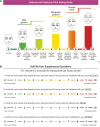Beyond measurement: a deep dive into the commonly used pain scales for postoperative pain assessment
- PMID: 38769013
- PMCID: PMC11220383
- DOI: 10.3344/kjp.24069
Beyond measurement: a deep dive into the commonly used pain scales for postoperative pain assessment
Abstract
This review explores the essential methodologies for effective postoperative pain management, focusing on the need for thorough pain assessment tools, as underscored in various existing guidelines. Herein, the strengths and weaknesses of commonly used pain scales for postoperative pain-the Visual Analog Scale, Numeric Rating Scale, Verbal Rating Scale, and Faces Pain Scale-are evaluated, highlighting the importance of selecting appropriate assessment tools based on factors influencing their effectiveness in surgical contexts. By emphasizing the need to comprehend the minimal clinically important difference (MCID) for these scales in evaluating new analgesic interventions and monitoring pain trajectories over time, this review advocates recognizing the limitations of common pain scales to improve pain assessment strategies, ultimately enhancing postoperative pain management. Finally, five recommendations for pain assessment in research on postoperative pain are provided: first, selecting an appropriate pain scale tailored to the patient group, considering the strengths and weaknesses of each scale; second, simultaneously assessing the intensity of postoperative pain at rest and during movement; third, conducting evaluations at specific time points and monitoring trends over time; fourth, extending the focus beyond the intensity of postoperative pain to include its impact on postoperative functional recovery; and lastly, interpreting the findings while considering the MCID, ensuring that it is clinically significant for the chosen pain scale. These recommendations broaden our understanding of postoperative pain and provide insights that contribute to more effective pain management strategies, thereby enhancing patient care outcomes.
Keywords: Pain; Pain Measurement; Perioperative Care; Postoperative; Postoperative Care; Postoperative Period; Visual Analog Scale.
Conflict of interest statement
Ho-Jin Lee is a section editor for the Korean Journal of Pain; however, he has not been involved in the peer reviewer selection, evaluation, or decision process for this article. No other potential conflict of interest relevant to this article was reported.
Figures



Similar articles
-
Pain Scales: What Are They and What Do They Mean.Curr Pain Headache Rep. 2024 Jan;28(1):11-25. doi: 10.1007/s11916-023-01195-2. Epub 2023 Dec 7. Curr Pain Headache Rep. 2024. PMID: 38060102 Review.
-
Defining the minimum clinically important difference for grade I degenerative lumbar spondylolisthesis: insights from the Quality Outcomes Database.Neurosurg Focus. 2018 Jan;44(1):E2. doi: 10.3171/2017.10.FOCUS17554. Neurosurg Focus. 2018. PMID: 29290132
-
Comparison of four pain scales in children with acute abdominal pain in a pediatric emergency department.Ann Emerg Med. 2007 Oct;50(4):379-83, 383.e1-2. doi: 10.1016/j.annemergmed.2007.04.021. Epub 2007 Jun 22. Ann Emerg Med. 2007. PMID: 17588706
-
Postoperative pain intensity assessment: a comparison of four scales in Chinese adults.Pain Med. 2007 Apr;8(3):223-34. doi: 10.1111/j.1526-4637.2007.00296.x. Pain Med. 2007. PMID: 17371409
-
Impact of summer programmes on the outcomes of disadvantaged or 'at risk' young people: A systematic review.Campbell Syst Rev. 2024 Jun 13;20(2):e1406. doi: 10.1002/cl2.1406. eCollection 2024 Jun. Campbell Syst Rev. 2024. PMID: 38873396 Free PMC article. Review.
Cited by
-
Validation of the Korean version of defense and veterans pain rating scale for assessment of postoperative pain: a prospective observational cohort study.Korean J Pain. 2025 Jan 1;38(1):58-68. doi: 10.3344/kjp.24346. Epub 2024 Dec 30. Korean J Pain. 2025. PMID: 39734066 Free PMC article.
References
Publication types
LinkOut - more resources
Full Text Sources

